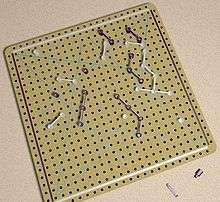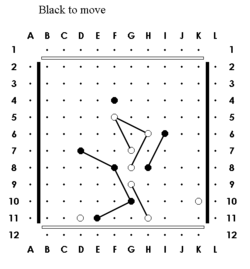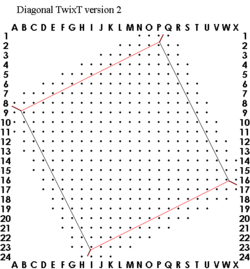TwixT
TwixT is a two-player strategy board game, an early entrant in the 1960s 3M bookshelf game series. It became one of the most popular and enduring games in the series. It is a connection game where players alternate turns placing pegs and links on a pegboard in an attempt to link their opposite sides. The rules are simple but the strategy complex, so young children can play it, but it also appeals to adults. The game has been discontinued except in Germany.


History
TwixT was invented as a paper and pencil game in 1957 by Alex Randolph, a game designer. When Alex was commissioned along with Sid Sackson by 3M in 1961 to start a games division, the game was issued as a boardgame, one of the first 3M bookshelf games. Avalon Hill took over publication in 1976 when 3M sold its game division. Avalon's parent company was acquired by Hasbro in 1998, and the game was discontinued. The game is no longer produced in the United States, but a succession of German companies has produced the game since the 1970s under license from Avalon. TwixT was short-listed for the first Spiel des Jahres in 1979,[1] and was inducted into the Academy of Adventure Gaming Arts & Design's Hall of Fame, along with Randolph, in 2011.[2]
Rules
Twixt is played on a board comprising a 24×24 square grid of holes (minus four corner holes). The playing pieces are pegs which fit the holes, and link pieces which join pegs along the diagonal of a 3×2 grid (i.e. the move of a chess knight). In the 3M edition, players are Red and Black; different sets may use different colors. The topmost and bottommost rows of holes belong to the lighter color; the leftmost and rightmost rows to the darker color.
- The players take turns placing pegs of their respective colors on the board, one peg per turn.
- The player with the lighter color makes the first move.
- A player may not place a peg on their opponent's border rows.
- To counteract first-move advantage, the pie rule is suggested. After the first peg is placed, the second player has the option to swap sides. This is typically indicated by turning the pieces box end for end, or swapping boxes if they are separate. If the second player chooses not to swap immediately after the first peg is placed, then sides may not be swapped later in that game. (This "one-move equalization" was added by Randolph after 3M published his game. It is present in the Schmidt Spiele edition and all later editions.)
- After placing a peg, you may link one or more pairs of pegs on the board which are all your own colour. The links can only go between two pegs a knight's move away from each other, and cannot cross another link; they block other links, most importantly the opponent's. As part of your move, you may remove your own links (but not your opponent's) in order to rearrange the sequence of links on the board. (Variant for pencil and paper play: you may cross your own links but not your opponent's. See below.)
- The object is to make a continuous chain of linked pegs connecting your border rows. If neither side can achieve this, the game is a draw.
Computational complexity for general rectangular boards
TwixT has been proven to be PSPACE-complete for determining the game value, via a reduction from Hex.[3] TwixT has also been shown to be NP-complete for whether a single set of vertices can support a connecting path, via a reduction from 3-satisfiability.[4] These proofs are indicative of a complex strategy: the game has not been solved, no winning strategy has been discovered, nor is the outcome of the game with perfect play known.
Related games
On the 24×24 grid, tactical considerations tend to predominate. The opening phase is over quickly, and the rest of the game is spent attempting to tactically execute the plan. Hex, which has a very similar game object, may have more predictable tactics, but strategical considerations are much more important. In this sense, Hex is more like Go than TwixT, since a single move is generally less committal, and consequences may take longer to play out.
Variants

One variant is Twixt PP (Paper and Pencil). The rules are almost identical to standard TwixT, except links are never removed and your own links are allowed to cross each other. A winning path might loop across itself but crossed links are not connected to each other at the intersection. The P-P rules may reduce the number of draws (already rare) and somewhat reduce the complexity of the game.
This rules difference makes no difference in terms of game outcome better than 99% of the time. Among those rare situations where it does, most of those cases are where a draw under standard rules is a decisive game under PP rules. The diagram shows a contrived position on a tiny grid where a win for black under PP rules turns into a win for white under standard rules.
Row handicapping can be used to equalize the game for players of different strengths. The simplest handicap is to allow the weaker player to move first (i.e. eliminate the pie rule). Beyond that, one dimension of the grid is reduced so the weaker player has a shorter distance to span.

The game may be played on different size grids. The 12×12 board shown here leads to a very short game. On the standard board, tactics dominate; larger boards introduce deeper strategic considerations. Since most commercial sets use boards which are made from four "quadrants" which either clip together or are hinged, a 36×36 grid could be assembled from three standard sets of the same size. In Europe, there briefly appeared a TwixT knock-off called "Imuri" which used a 30×30 grid. The board had no holes, and lines were drawn to indicate where the links could be placed. This edition was removed from shelves for copyright infringement.
Mark Thompson's variant Diagonal TwixT has the same rules as standard TwixT, but the border lines run at a 45 degree angle to the grid.[5] David Bush's version has the border lines running parallel to link paths. These variants result in different tactical patterns.
Competition
The official world championships were held as part of the Mind Sports Olympiad in 1997, 1998 and 1999.[6] Since 2000 TwixT has had a major international tournament as part of the MSO but there has been no official World Championships. Since 2011, the TwixT event at the MSO has again become the World Championships. The list of winners is given below.[7]
List of MSO champions
- 1997:

- 1998:

- 1999:

- 2000:

- 2001:

- 2002:

- 2003:

- 2004:

- 2005:

- 2006:

- 2007:

- 2008:

- 2009:

- 2010:

- 2011:

- 2012:

- 2013:

- 2014:

- 2015:

- 2016:

- 2017:

- 2018:

- 2019:

See also
- List of connection games
- Gale, also called Bridg-It
References
- Spiel des Jahres page in German for TwixT
- Origins Awards Hall of Fame for TwixT
- Bonnet, Édouard; Jamain, Florian; Saffidine, Abdallah (14 August 2013). Havannah and TwixT are PSPACE-complete. The 8th Intl. Conf. on Computers and Games. Keio University, Yokohama, Japan. arXiv:1403.6518. doi:10.1007/978-3-319-09165-5_15.
- Dominic Mazzoni and Kevin Watkins (October 1997). "Uncrossed knight paths is NP-complete".CS1 maint: uses authors parameter (link)
- "Mark Thompson's TwixT webpage". Archived from the original on 9 May 2011.
- Mind Sports Olympiad TwixT Results http://www.boardability.com/result.php?id=twixt 10 July 2010
- MSO main website showing results http://www.msoworld.com/results/ [retrieved 21 May 2016]
External links
- Introduction to TwixT on the International Computer Games Association website. Introduction, rules, computer-TwixT related links
- TwixT at BoardGameGeek
- Sensei's Library: Twixt More info about TwixT
- Current Twixt-playing programs